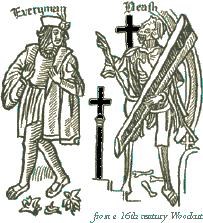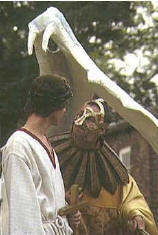The Miracle Plays
The Miracle plays are known as well as Pageants, or Pageant Plays, Passion Plays, as well as Mysteries, because of the mystery of Christ, and studied today most particularly in theatre courses or in reference to the early English drama, either pre-Shakespeare or in adjunct to Shakespeare survey courses. What follows may be a bit brief, and may entail a bit of generalization, but the study of these plays occupies more than a few semesters in merely learning the basics.

Probably in the 10th century, the first true "dramatic" action took place after a four-century dramatic hiatus: the Church had banned dramas in the 6th century. The "Visitatio" (visit to the sepulcher) reenacted the visit of the two Marys and Martha to the tomb of Jesus on Easter morning. Priests took the parts of the women, as the angel inquires of them, "Whom do you seek?" Their answer is met with "He is risen." The action is simple though moving, and the dialogue was chanted (obviously in Latin).
The Church presented other similar actions within its structures; however, there's a continuing argument as to whether such dramatic action led to what can be described as "theatre" outside the church, that is, in the market place or village greens. However, that the drama grew until the church could no longer contain it, that it became ever more secular, is a simplistic and misguided notion as to the origin of the English drama. The development may have been simultaneous rather than evolutionary. Certainly in the secular world, the court jester and troubadour continued the tradition of the player, by singing, juggling, doing acrobatic feats and such.
A change in how the church viewed Christ also takes place about the 10th century, with the humanity�and especially the death�of Jesus being reasserted. Depictions of the crucifixion and his suffering became paramount. In 1311, Clement V implemented the feast of Corpus Christi, confirming a papal bull from nearly 100 years earlier that asserted the real presence of Christ in the mass: the dogma of transubstantiation. The celebration was to fall, depending on Easter Sunday, between May 23 and June 24 (June 4 to July 6 on the modern calendar).
What were to become the plays of Corpus Christi probably began with the host being carried through the streets by a priest and procession. This procession was expanded to include tableaux vivant, living pictures, in which people recreated a biblical scene, such as the sacrifice of Isaac, on the back of pageant wagons pulled by oxen. These living pictures eventually were enlarged in numbers until many scenes from the Bible were paraded past a largely illiterate populace; thus the Mystery Plays (as we have come to call them, since they depicted the mysteries of salvation and God's plan for humanity) were meant to be instructional and edifying.
Soon action and dialogue were given to the scenes; they recreated biblical
stories from the creation of the world to Judgment Day, events which the
people regarded as literal history, not something separate from a secular
past, and all actions were meant to celebrate the coming of Christ, record
his deeds, his death, and conclude with his sitting at the right hand of
God. All dramatic episodes demonstrated fore-tellings of Christ; Abraham's
intended sacrifice of Isaac, for instance, points to
 God's
sacrifice of His only son. Literature defined the event in terms of a
typological (or anagogical) mode of allegory: Abraham forces his son to
carry the wood for his sacrifice, to journey three days, and be sacrificed
as a means to satisfy the Lord. People who watched the pageant wagon pass
before them depicting Abraham's unquestioning obedience to God were
well-aware of the allegorical lessons that such a sacrifice conveyed�they
viewed the plays much as listeners would pay heed to Christ�s parables and
learn from the stories. They believed, without hesitation, that these
things existed, and anyone who maintained otherwise failed to pay attention
to "history." The plays, however, were sophisticated, often employing
machinery for angels or trap doors for Satan, and at times quite graphic and
violent.
God's
sacrifice of His only son. Literature defined the event in terms of a
typological (or anagogical) mode of allegory: Abraham forces his son to
carry the wood for his sacrifice, to journey three days, and be sacrificed
as a means to satisfy the Lord. People who watched the pageant wagon pass
before them depicting Abraham's unquestioning obedience to God were
well-aware of the allegorical lessons that such a sacrifice conveyed�they
viewed the plays much as listeners would pay heed to Christ�s parables and
learn from the stories. They believed, without hesitation, that these
things existed, and anyone who maintained otherwise failed to pay attention
to "history." The plays, however, were sophisticated, often employing
machinery for angels or trap doors for Satan, and at times quite graphic and
violent.
One hundred years after the implementing of the feast of Corpus Christi the pageants had grown as civic as well as religious celebrations, with so many biblical scenes enacted that the celebration began at 4:30 a.m. and continued well past dark. Each wagon probably stopped at pre-arranged stations as they wended through the streets of towns such as York, Wakefield, Coventry, or Beverly, so that one play was performed many times in the course of a day. Some scholars of the medieval drama have suggested that they also lined up for one performance that moved from wagon to wagon in a fixed location at day's end. Whatever the actual logistics of their performances, the mysteries became sophisticated theatre, with "professional" involvement, where the necessity of merging commerce and religious pageantry intertwined.
The trade guilds were given the responsibilities of funding and casting particular pageants. This association was made relevant to their craft: the carpenters' union, for example, depicted the crucifixion of Christ, the boat makers enacted the story of Noah and the ark, the butchers enacted Abraham and Isaac, etc.
The mysteries, also called pageants or miracle plays (more specifically referring to the miracles of Christ or the saints), or Corpus Christi plays, were suppressed by the Crown in the 1560s, Elizabeth I and England were Protestant, and the mysteries were seen as holdovers from the nation's Catholic past.
Mystery plays are not to be confused with Morality Plays, which date to the early 15th century and were contemporaneous with the mysteries, though largely known for their popularity in the 16th century, especially as substitutes for the Corpus Christi pageants. These plays were fixed in location and represented personifications and examples of piety: "Mr. Good Deeds," "Honest Recreation," "Mr. Bad Man," or "Tediousness" are examples. These stilted, and, for those who will admit it, boring plays were in no way equal to the beauty and grandeur of the pageants but were far more specific and quotidian in their moral statements (there are exceptions; the moralities in fact are good theatre when performed, reading them is deadly; but that holds true for the exaggeration above as to the tediousness of the Moralities: when played well, they're delightful; we should always remember that drama is not meant to be read).
The morality plays were, for the most part, the precursors to the Elizabethan stage with the vice character in particular enlarged into the role of clown or tragedian. Whereas biblical figures such as God, Satan, or Christ are largely fixed in definition because of their stature, their mythological proportions--and thus not the stuff of good dramatization; the vice figure, the companion to Satan, was pliable and could be developed. Shakespeare's Iago represents an excellent example. Some material became standard: for instance, Noah and the Ark was always a humorous episode, depicting Noah as a well-intentioned if bungling man with a shrewish wife. The Noah episode was always presented as one of great fun, showing the tensions between husband and wife--the ark and animals were almost an after-thought.
It is admittedly difficult to say more concerning one of the most memorable narratives of the Hebrew Scriptures. That the Abraham and Isaac story has been co-opted by Christianity is well known, but we cannot say that such a circumstance is bad. The narrative holds a wealth of emotion, for those who view it as typological or anagogical in its fore-shadowing of the agony and sacrifice of Christ to the other extreme: those who view it as a barbaric illustration of God�s unnecessary test of a man previously promised and then given a child in his later years. What it has yielded in terms of literary fodder is more than evident today.
However we read it, obviously it has much to offer, from Auerbach's essay that identifies it as exemplifying the differences in Hebraic and Greek writing, to the allegorical mode of thought, to the reminder of the most specific covenant the Lord God made with a specific people, not humanity in general. For those who know the story, looking back at Abraham's "trial" by God establishes the reason for Isaac's son, Jacob, establishing the basis for and representation of God's chosen people through the nations who will one day compose Israel. That is far off and in the future; however, the time at which these narratives were written not only celebrates that time but finds itself within that glorious period of Solomon, the Temple, and the might of the two kingdoms combined as one, both Northern and Southern, into the land of promise. This was the beginning: what follows is, literally, already written.